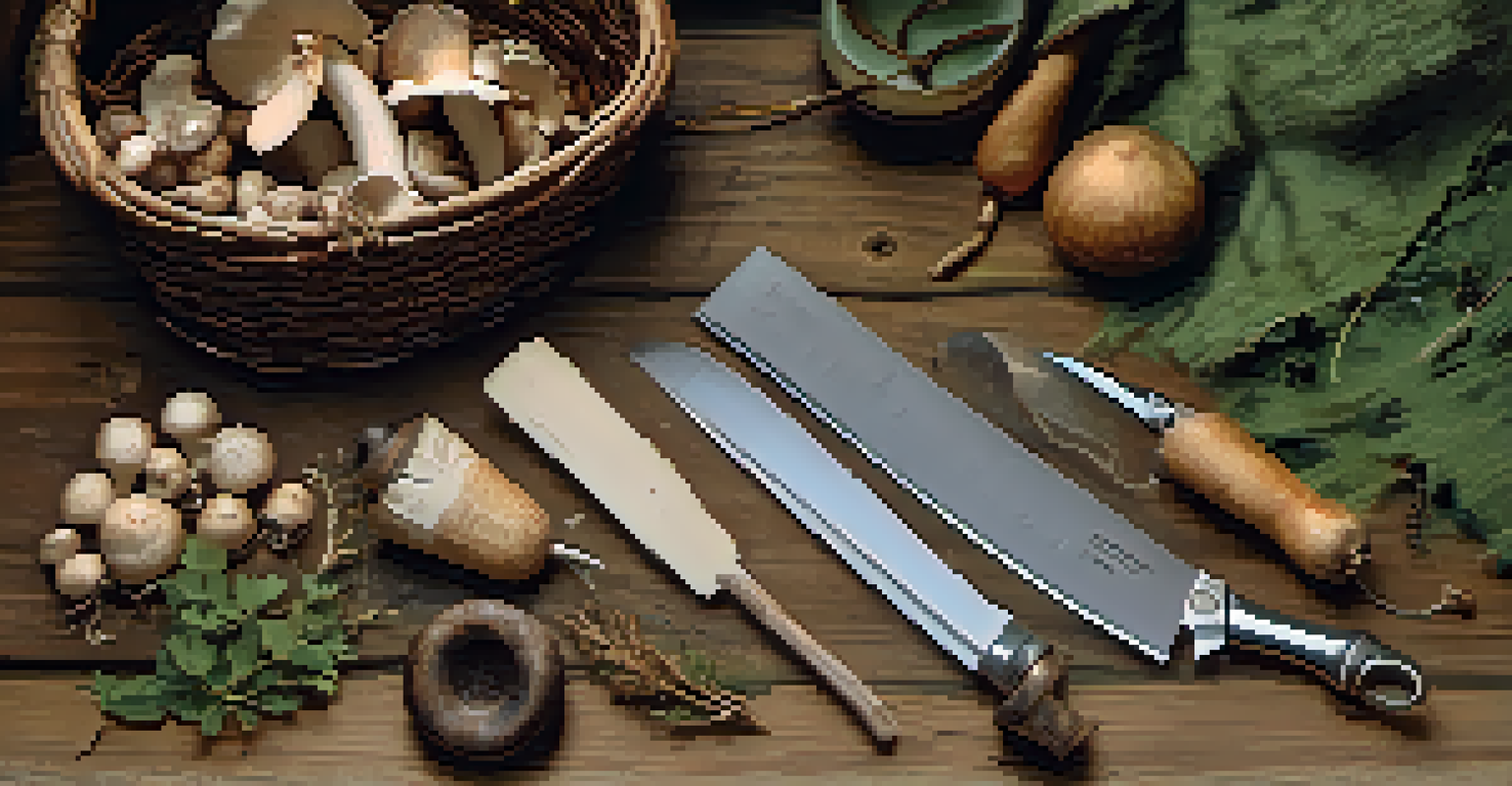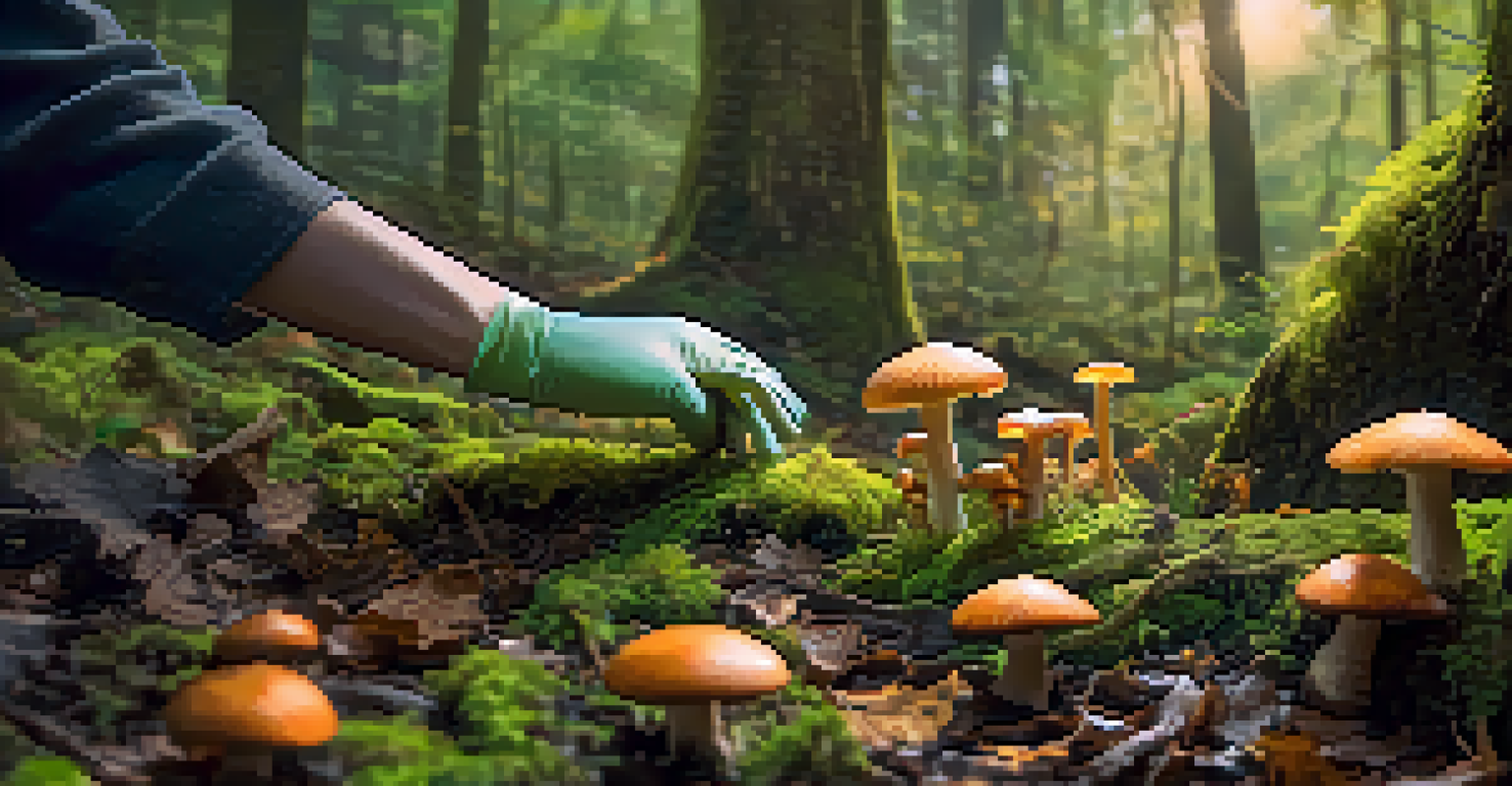Foraging Tools: Essential Gear for Wild Food Gatherers

The Importance of the Right Foraging Tools
When it comes to foraging, having the right tools can make all the difference. Imagine heading out into the wild without a map; you might find some great spots, but you could also miss a treasure trove of edible plants. The right gear not only enhances your efficiency but also ensures that you’re gathering safely and sustainably.
The best way to find yourself is to lose yourself in the service of others.
Choosing tools that suit your needs and environment is essential. For instance, if you're foraging in a dense forest, you might need a sturdy knife for cutting through thick underbrush. On the other hand, if you're near the coast, a good pair of gloves might be more critical to protect your hands from sharp shells or prickly plants.
Ultimately, the right tools empower you to explore and enjoy nature while gathering delicious, nutritious wild food. They help you to feel more connected to the environment and increase your chances of a successful foraging adventure.
Essential Knives for Foraging
A good knife is arguably the backbone of any forager's toolkit. Whether you’re slicing through tough roots or delicately cutting mushrooms, a sharp, reliable knife can facilitate the process. Look for a compact, folding knife that can easily fit in your pocket; this way, you’ll always be ready for a spontaneous foraging trip.

Different types of knives serve different purposes. For example, a paring knife works wonders for fruits and vegetables, while a serrated knife can tackle tougher plants with ease. Investing in a quality knife not only makes your foraging smoother but also ensures you stay safe while working with sharp tools.
Essential Tools Boost Foraging Success
Having the right foraging tools, like knives and baskets, enhances your efficiency and safety while exploring nature.
Remember to keep your knife clean and sharp. A well-maintained knife will not only be more effective but also safer to use, reducing the chance of accidents while you're out in the wild.
The Role of Foraging Baskets
Foraging baskets are more than just stylish accessories—they serve a vital function in the gathering process. These baskets allow for proper ventilation, which is key to keeping your foraged goods fresh. As you collect wild edibles, a breathable basket will prevent moisture build-up, reducing the risk of spoilage.
In every walk with nature, one receives far more than he seeks.
When choosing a basket, consider its size and weight. A lightweight, spacious basket will enable you to gather more without feeling bogged down. Additionally, many foraging baskets come with handles that make transporting your finds a breeze, which is especially helpful if you plan to hike back to your vehicle.
Ultimately, a sturdy basket can enhance your foraging experience, allowing you to focus on the joy of gathering rather than worrying about how to carry your prized finds.
Gloves: Protection and Comfort
While foraging can be a delightful experience, it’s important to consider safety, and that’s where gloves come in. A good pair of gloves protects your hands from prickly plants, sharp shells, and even potential allergens. Choosing the right gloves can make your foraging experience more enjoyable and less stressful.
Opt for gloves that offer both protection and dexterity. You’ll want something thick enough to guard against thorns but flexible enough to allow for careful picking. Leather gloves are a popular choice, but many foragers also prefer nitrile-coated gloves for their grip and water-resistance.
Safety Gear Is Crucial for Foragers
Equipping yourself with safety gear, including gloves and a first-aid kit, is vital for a worry-free foraging experience.
In essence, gloves are an essential piece of gear for anyone serious about foraging. They safeguard your hands while allowing you to engage fully with nature, letting you focus on the thrill of discovery.
Tools for Identification: Field Guides and Apps
Identifying wild edibles can be overwhelming, especially for beginners. This is where field guides and mobile apps come into play. A well-illustrated field guide can offer detailed information on various edible plants, including their characteristics and habitats, making it easier to recognize them in the wild.
Mobile apps have revolutionized foraging, providing instant access to a wealth of information right at your fingertips. Many apps include features like image recognition, which can help you identify plants quickly and accurately. This instant feedback can boost your confidence as you learn to forage.
By utilizing both field guides and technology, you can enhance your foraging skills significantly. These tools not only help you gather safely but also deepen your appreciation for the natural world around you.
The Importance of Foraging Bags
While baskets are great for ventilation, foraging bags provide versatility. A sturdy foraging bag can be used to collect a variety of items, from berries to mushrooms, without the bulkiness of a basket. It’s especially useful if you plan on traversing uneven terrain where a basket might not be practical.
When selecting a foraging bag, look for one that is durable and easy to clean. Many foraging bags come with compartments to help you separate different types of edibles, preventing the mingling of flavors and textures. This can be particularly important if you're foraging for mushrooms, as some species can be toxic.
Identify Edibles with Guides & Apps
Using field guides and mobile apps can significantly improve your ability to identify wild edibles confidently.
In the end, a good foraging bag can simplify your gathering experience, allowing you to focus on finding and enjoying nature's bounty without the hassle of an unwieldy basket.
Safety Gear: Staying Prepared
Foraging can be fantastic fun, but it’s important to prioritize safety. Having a first-aid kit on hand is essential, as it prepares you for any minor mishaps like cuts or insect bites. Being ready for the unexpected ensures that you can enjoy your adventure without unnecessary worry.
In addition to a first-aid kit, consider packing a whistle and a map. These items can be lifesavers if you find yourself lost in the woods. A whistle can attract attention, while a map helps you navigate back to safety, adding an extra layer of security to your foraging trips.

Ultimately, being prepared with the right safety gear can enhance your confidence and peace of mind as you explore the wild. With these precautions in place, you can fully immerse yourself in the joy of foraging.